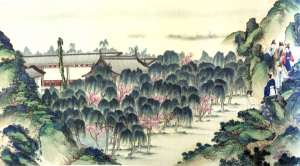
Sun, Wen. A Dream of Red Mansions: As Portrayed through the Brush of Sun Wen. Zurich: Shanghai, 1020 p.48.
Introduction
Dreams of Red Chambers often features pink-petaled trees scattered across the pages. While the trees depicted in this picture are likely to be cherry blossoms due to the number of other plants in bloom, plum blossoms look very similar and would be illustrated in the same manner. The trees are usually grown alongside trees of other types and are quick to liven up the scenery and add more color to the fields, especially during the winter. The plum blossom tree has existed and been used in China for an extremely long time. Plum trees are usually between four and ten meters tall. Their bark is grayish and the tree itself is fairly skinny. The flowers that sprout from the branches are either white or pink and fruit grows from the branches as well. The plum blossom tree holds importance in Chinese society through its cultural significance. Chinese plums have been discovered in several tombs in Kiangsu, Hupei, Kuangtung, and Kuangsi. This discovery suggests that they were an important ancient food crop because of how far back they were used and how they were included in the tombs.
Where it is grown
The plum blossom grows widely in China, from Heilungkiang in the north to Kuangtung and Kuangsi in the south and Tibet in the west. They are cultivated throughout China but are mostly cultivated south of the Chiang Jiang river. They can be found growing naturally along forested slopes, sparse forests, along streams, and on mountains.
Uses
The plum blossom trees are seen as an ornamental plant that could be used for more than improving the scenery. The flowering plum fruit was a highly significant item of the Ming diet. Its fruits are still cultivated for nutritional purposes. The fruits are incredibly versatile as to what you can create with them. They are able to be candied, dried, honeyed, and pickled. In addition, they can also be used to make a sour plum sauce that when diluted with water, became a summer beverage. As far as beverages go, plums can be used to create liqueur as well. The plum blossom tree is not simply decorative and the fact that its fruit could become so many different types of food made it useful to the Chinese. Even to this day, its flowers make for a tourist attraction that brings China a lot of money.
Artistic Representation
Plum blossoms are depicted everywhere from pottery to wall scrolls because of their scenic properties and symbolic meanings. Plum fruits are a symbol of fertility in China. The plants themselves are a symbol of perseverance because of how they bloom in the cold winters. Due to them being the first flowers of the year, they also represent renewal and purity. Due to having five petals, they are also a representation of success and prosperity due to the number being sacred in Chinese culture. They are often depicted in many forms of art as long extended flowering branches with wildlife around it. Because of how they are perceived as well as their beauty, there are many pieces of art depicting the plants blooming flowers.
Environmental Issues
There are a few issues surrounding the cultivation of plum blossom trees. Only cultivating one type of tree on the same soil can hurt the soil that the trees are grown in. It can do this by draining the soil of its essential nutrients. In addition to that, removing all of the other plants in the area of land needed for the plum blossom trees can remove animals from their natural habitats. Discouraging insects from eating the plums with pesticides can also be very harmful to the water it washes off into, the insects living in the area, and the humans and animals that ingest it by consuming the water.
Questions
What factors into the plant’s popularity?
Why is there so much artwork of the plant?
Why is the plum blossom tree valued for its scenery as much as it is?
Citations
- Au, Dawn Tung, Jialin Wu, Zhihong Jiang, Hubiao Chen, Guanghua Lu, and Zhongzhen Zhao. “Ethnobotanical study of medicinal plants used by Hakka in Guangdong, China.” Journal of ethnopharmacology 117, no. 1 (2008): 41-50.
- Clunas, Craig. Fruitful sites: garden culture in Ming dynasty China. Reaktion Books, 2013.
- Huff, Toby E. The rise of early modern science: Islam, China, and the West. Cambridge University Press, 2017.
- The Land of the Five Flavors: A cultural history of Chinese cuisine. Columbia University Press, 2013.
-
“Chinese Symbols.” The British Museum.



